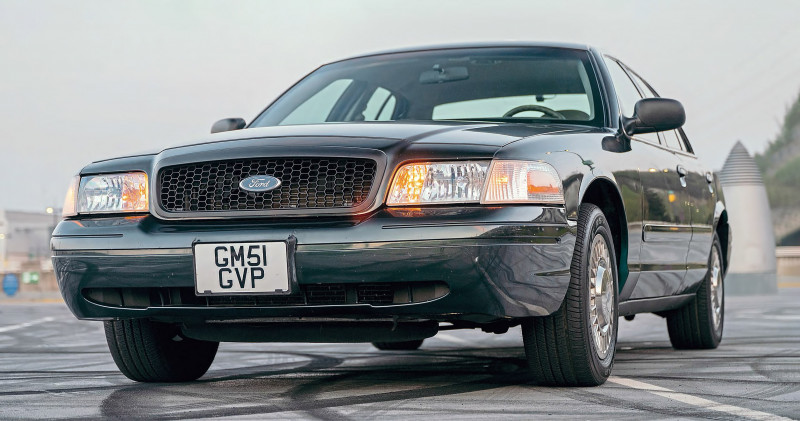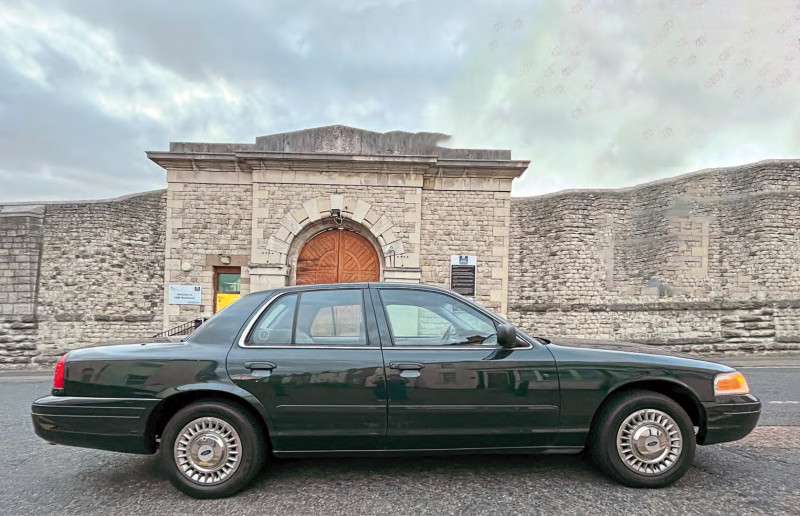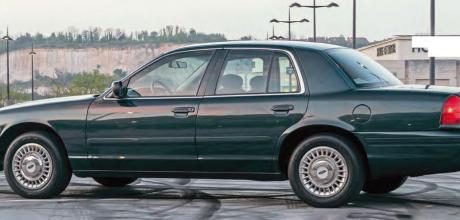2002 Ford Crown Victoria P71 Police Car
Classic American photographer Matt Richardson realised a dream after doing his automotive research for more than a decade on how to buy the perfect Ford Crown Vic P71 US police car. Only after searching the whole of America did he find the one that he always wanted: detective spec, low mileage and dark…
Words and photography: Matt Richardson
STRIKING GOLD
HOW TO IMPORT AMERICA'S FAVOURITE COP CAR

I have a confession. I’ve been a Classic American photographer since 2005, and in those 17 years have shot, sat in and ridden in literally hundreds of American cars. I’ve been to America many times, driven Route 66 and even got married in LA. But I’ve never owned an American car − until now. Now, you might wonder what caught the eye of someone whose job it is to stare at classic cars all day and across the decades of fenders, fins, chrome, fuselage body and malaise-era excess. There have been many temptations, but the model which summed up America in one car for me was the Crown Vic, specifically the 1998-2011 ‘whale’. A car so ever present, it’s almost part of the background. A car which movie makers just have to drive past the camera to tell the audience “we’re in the US”. With every trip to the US, my minor obsession grew. The first time I went to America, I rode in a Crown Vic Yellow cab shortly after 9/11, in a deserted New York. My hotel’s Lincoln Town Car − the posh Crown Vic − was being used for airport runs. On later trips, I found myself grabbing photos of cop cars and taxis, which were Vics. At taxi ranks, I’d let other passengers go first so I could take a ride in a Crown Vic. In Santa Fe, I rode in a 400,000-mile taxi which was an ex-police car, but was still going strong. And that’s what I decided I wanted: an expolice car. They might not have the eye-catching chrome of a classic, or the luxury of a Cadillac, but they do have an unmistakable charm and undeniable toughness; putting it bluntly, a truck chassis with a car body and a muscle car engine. So, while I could have had a well-equipped Panther platform car like a Mercury Marauder or a comfy civilian Crown Vic or Lincoln which would have been easy to find, the cop cars take the engineering to a different level and that also impressed me.

When hunting for a cop car, the P71 (and later P7B) chassis code-marks out the Police Interceptor or CVPI models, which were built for law enforcement use only and are uprated from the chassis up; they have to withstand a 70mph rear impact for traffic stops. They have a more powerful version of the modular 4.6-litre V8, with dual exhausts and different manifolds, a bigger radiator and additional coolers for the engine, transmission and power steering so they can drive faster for longer or idle for an entire shift, if needed. There’s a lightweight aluminium driveshaft and the heavy-duty suspension is actually raised about 20mm so they can crash over kerbs.
Then there’s the interior. As standard, all CVPIs come with hard-wearing, cloth-covered front bucket seats − although this is stretching the term ‘bucket’ to breaking point − a wipe-clean vinyl rear bench and rubber floor matting for easy cleaning, in case your passengers are… unwell. There’s a large ticket writing light in the ceiling, and hidden in the seat backs are stab-proof Kevlar panels in case your rear passengers are less friendly. So not luxurious, but very interesting. I started looking a few years ago and found an ideal car in Los Angeles, but the cost of import duties put me off and I put it to the back of my mind, but in 2021 as the 10th anniversary of the last Crown Vic rolling off the line approached, I decided it was now or never. I had a perfect car in mind. Detective-spec cars sometimes have the optional cloth back seat or even velour and carpet. They also tend to live an easier life and be lower mileage than a patrol car which will have been rolling or idling almost non-stop and more likely to have been in an accident or three. Also on the wish list was a black car with a nudge bar and Appleton spot lamps. So, with all of America to look through, I started the search in earnest. As ‘P71 Crown Victoria’ was already a regular eBay search term, I knew of a couple of dealers in the US and had been looking at their stock and emailed about a couple of cars, but there were alarm bells, like a full respray and odd marks. However, using a website called Auto Tempest I was able to find every Crown Victoria for sale in the US, and there weren’t as many as you might imagine.
Condition aside, the first thing to check on any advert was whether the car was a genuine CVPI as these are becoming more collectable, as are the ‘P70’ chassis-code taxis, so some are faked, and there are a couple of clues aside from the VIN. The twin exhausts are hard to see, but they should have a ‘Police Interceptor’ badge on the boot instead of ‘Crown Victoria’, unless it’s a Street Appearance Package car (SAP cars had hubcaps and a chrome grille), the words ‘Certified Calibration’ on the speedo and the trunk release button is in the centre of the dash so both crew can reach it.
Research, research and ask an expert
When buying a car abroad, it's important to remember to factor in import costs, and I found a few perfect cars at the top of my budget which wouldn’t have left enough to ship one home. But after a couple of false starts − a silver 2008 in New York with a rattling engine for an amazing price, and a slightly battered, but low-mile car in the mid-west − I found the perfect car in LA, a 2004 Ex-LAPD detective car in black with spot lamps and just 120,000 miles and good idle hours for about $5000. I emailed the dealer and then phoned and offered a deposit to hold the car, which he refused. His word was his bond, apparently.
As this is a big endeavour, I wanted to know it was a good car, so got straight on the phone to Golden Chariots (www.goldenchariots.com/ Tel. 01902 790797) to take care of everything, including arranging an inspection for the next day. The results were good and bad. The inspector emailed a full report showing the car was better than I’d expected. However, the dealer sold it to a walk-in customer while the inspection was actually happening. I was furious, so being British emailed to say I was disappointed. Back to Auto Tempest, and at this point I could tell you the mileage and spec of every CVPI for sale in America from a photo of the wheel trim. Then, over breakfast one September Sunday, almost 10 years to the day the last Crown Vic was built, I spotted an eBay auction I’d missed which was ending in an hour. It looked perfect, although a pre-update car.
Dark paint, although the photos were a bit ambiguous on the actual colour. Only 80,000 miles, which is astonishing on a 2002 car that had been in service 18 years. There was an assurance it had low idle hours and no patrol work, as the dealer in a small Ohio town had bought it straight from a government auction in the nearby city of Beachwood. Quoting the advert: “not full of holes inside and out, has not seen the daily grind that patrol cars have seen. Was used in the City of Beachwood and garage-stored nightly”. At $4750, it looked amazing and in my Sunday morning brain fug, I remembered Ohio is in the warm middle bit of America (don’t judge me!). Having been stung once before, I read and re-read the listing and with minutes to run on the auction I sent an offer of $4500. Moments later my email pinged. I’d bought a Crown Victoria.
I used PayPal to send the close to £4000 (including various fees) and then handed over to the experts; having Golden Chariots arrange to have the car trucked the 500 miles from Perry, Ohio, to New York to wait for a ship home. While I could have hit Google and found a transport company and shipping line and dealt with the paperwork myself, having an experienced shipper look after things removes all the stress; I just had to fill out any documents asked of me and wait. And wait. And wait.
Now, the longest weeks of my life began. This was at the height of the global shipping crisis, so although the Ford arrived in New York at the end of September it couldn’t get on a ship until late November, with just the port’s receiving photos to keep looking at, although now I knew for sure it was dark green.
It crossed the Atlantic containerised. Golden Chariots normally uses a RoRo service which it trusts and has no problems with, but with no availability used a container service which it could also trust, and I watched almost every nautical mile on Ship Tracker as it went up and down the US east coast before finally heading to the UK.
On arrival and once customs have been cleared, the docks give a fairly short window to collect before storage charges are added by the day, so I was ready with a transporter on speed dial; a tricky feat as at five metres long it’s the size more than the weight of the Crown Vic which puts it over the capacity of most tow trucks. You can insure a fresh import on the VIN and drive it away, but that should be directly to a booked MoT although it will fail without the relevant changes for UK compliance being made, so I went with the transporter to Southampton.
Arrival
My first glimpse was through a chain-link fence and after handing over a customs clearance form it was driven out of the secure area and I saw my Crown Vic properly for the first time, and it was glorious. The condition was as expected − a huge relief. A tiny bubble on one wing, which had been repainted as I’d suspected from photos, but overall in great shape, and checking the codes in the door slam found I’d hit the rear-axle jackpot with the X5 code, meaning the fast acceleration 3.27:1 Trac-Lok limited-slip diff option was ticked, one of my bucket list options but hard to check.
Up close, I could see that three wings had been painted, possibly from forcing cars to stop, and there is a blister on the front wing. As my car is 2002, it didn’t need an IVA (Individual Vehicle Approval) inspection; just an MoT to begin registration, and getting an American car through its first test needs a couple of lighting changes. Being left-hand drive the headlights usually point the wrong way, but Vic’s have a ‘flat beam’ which points almost straight forward and has no lens to bend the beam, so just needed tweaking left.
Next up is the lack of rear fog lamp which under new rules has to switch off with the lights and not come back on again. This could be an ugly haemorrhoid-like lamp under the bumper, but much cleaner is to sacrifice a reverse light and replace its bulb with a high intensity red LED wired to a momentary switch in the lighting circuit.
The trickiest change is the indicators. I spoke to my MoT tester who confirmed I could leave the front flashers alone, and although there are no side repeaters, as that’s how it left the factory, it is a pass, but worth adding if possible. The problem is at the back, as Crown Vics started with an orange rear-turn signal at the base of the light cluster, but soon merged stop and turn into the same red cluster, leaving an empty red lens below; great for cop strobes, but bad for MoTs.
I could have bought orange-lensed lamps, but like the all-red look, and after some research found that a green light through a red lens shows orange. Ain’t science great? And so is Amazon, as I found the correct fitment bulbs in green so bought four and cut into the loom, taking a stop light signal from the high level brake light and taking a separate feed for the indicators. I got it 90% right but had to call an auto electrician who finished up, locating a flasher relay in the boot to feed them. Before the MoT, I also got under the car for a look and was gobsmacked at how solid the thing is. I’d now discovered that Ohio is in the snow belt and cars dissolve in that region, but this was as clean and smart underneath as on top, so I undersealed it ready for British winter and booked an MoT. After three months I was finally able to take my first drive in my CVPI.
We made it to the garage fine, but as I pulled in noticed smoke from the front passenger wheel. Test abandoned, I headed home with a binding brake caliper − it was lucky I hadn’t tried to drive all the way from Southampton. Many non-owners assume getting parts for American cars will be hard, but I’d already found the oil filter is shared with a V6 Mondeo and most Classic American advertisers are able to ship parts in a couple of days, with US car-part prices being very reasonable.
The police garage had kept it well maintained as it had brand new discs and pads, but the calipers must have seized from sitting around a long time, so I swapped both front calipers which looked original and massive, like truck equipment. Back to the MoT, which I needed to register with the DVLA, and it passed, with just advisories for a drop link and front shocks, so back to the parts supplier and more correct cop-spec parts were fitted while I waited for the V5 paperwork to be processed. The DVLA has a bad reputation for delays, but after filling in form V55/5 to register a used vehicle and sending that along with the US Title, a copy of my MoT, insurance, proof of ID and cheques for both the registration fee and first six months’ tax, it took the predicted three weeks to issue a V5 and registration number − although I thought it should have had a 52 plate; January 1 seems to be used as a default so it got a 51 and a GM area code on a Ford!
“I’VE USED THE CROWN VIC AS MUCH AS POSSIBLE, FROM TAKING IT TO THE SHOPS AND SHOWING IT AT THE NEC IN THE SPRING, AND LOVE DRIVING IT AND THE REACTION IT GETS.”
‘Police Interceptor’ badge means it’s kosher. Right: Doughnut shop in Beachwood: Crown Vic probably spent many hours here! Well-maintained 280cu in/4.6-litre modular V8.
Plush velour seating. Inset: Inspection report from UK landing. Practical vinyl rear seat.
Subtle colour is in fact a very dark green. CA photographer: Matt Richardson. Chrome wheels are part of the package.


